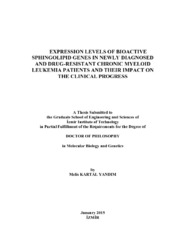Please use this identifier to cite or link to this item:
https://hdl.handle.net/11147/4285| Title: | Expression Levels of Bioactive Sphingolipid Genes in Newly Diagnosed and Drug-Resistant Chronic Myeloid Leukemia Patients and Their Impact on the Clinical Progress | Other Titles: | Yeni Tanı ve Dirençli Kronik Miyeloid Lösemi Hastalarında Biyoaktif Sfingolipid Genlerinin Ekspresyon Düzeyleri ve Klinik Seyire Etkileri | Authors: | Kartal Yandım, Melis | Advisors: | Baran, Yusuf | Keywords: | Cancer patients Hematologic diseases Leukemia |
Publisher: | Izmir Institute of Technology | Source: | Kartal Yandım, M. (2015). Expression levels of bioactive sphingolipid genes in newly diagnosed and drug-resistant chronic myeloid leukemia patients and their impact on the clinical progress. Unpublished doctoral dissertation, İzmir Institute of Technology, İzmir, Turkey | Abstract: | Bioactive sphingolipids are a family of lipids including ceramide, glucosylceramide (GC), sphingosine-1-phosphate (S1P) and ceramide-1-phosphate (C1P) that have important functions in cellular processes including proliferation, metastasis, invasion, inflammatory response and apoptosis. Many sphingolipidregulated functions are directly related to cancer initiation, progression, and response or resistance to anti-cancer treatments. Ceramide, the central molecule of the sphingolipid metabolism, functions as a tumor-suppressor inhibiting cell division, and inducing cell differentiation, senescence and apoptosis. De novo synthesis of ceramides is regulated by ceramide synthase gene family (CERS1-6). Although ceramide is known to be a pro-apoptotic molecule, GC and S1P which are converted from ceramides by glucosylceramide synthase (GCS) and sphingosine kinase-1 (SK-1), respectively, are anti-apoptotic. Chronic myeloid leukemia is a hematological disorder arisen from the reciprocal translocation between BCR gene on chromosome 22, and ABL gene on chromosome 9, t(9;22)(q34;q11), resulting in the formation of Philadelphia (Ph) chromosome. Ph chromosome encodes BCR/ABL fusion protein having constitutively active tyrosine kinase activity. In this study, we examined the expression levels of CERS1-6, GCS, SK1, and BCR/ABL genes of 66 patients that are newly diagnosed, tyrosine kinase inhibitor (TKI)-resistant, or -sensitive. Q-PCR results showed that there were higher expression levels of apoptotic CERS1-6 in the patients TKI-treated and have shown minimum hematological response than that of the patients newly diagnosed and TKI-resistant. However, expression levels of antiapoptotic GCS and SK-1 genes were significantly higher in TKI-resistant and blastic phase patients than that of the other patients. Additionally, BCR/ABL expression levels were higher in newly diagnosed and TKIresistant patients. | Description: | Thesis (Doctoral)--Izmir Institute of Technology, Molecular Biology and Genetics, Izmir, 2015 Includes bibliographical references (leaves: 78-94) Text in English; Abstract: Turkish and English xii, 94 leaves |
URI: | http://hdl.handle.net/11147/4285 |
| Appears in Collections: | Phd Degree / Doktora |
Files in This Item:
| File | Description | Size | Format | |
|---|---|---|---|---|
| T001308.pdf | DoctoralThesis | 4.22 MB | Adobe PDF |  View/Open |
CORE Recommender
Page view(s)
258
checked on Apr 28, 2025
Download(s)
150
checked on Apr 28, 2025
Google ScholarTM
Check
Items in GCRIS Repository are protected by copyright, with all rights reserved, unless otherwise indicated.